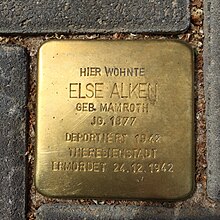Else Alken
Else Alken , née Else Mamroth , (born May 14, 1877 in Breslau ; † December 24, 1943 in Theresienstadt concentration camp ) was a German politician of the Center Party who was a victim of the Holocaust .
family
Else Alken was the daughter of the journalist Fedor Mamroth and his wife Johanna nee Schwabacher. She was of Jewish origin and was baptized according to the Catholic rite on her 18th birthday .
She married on January 9, 1904 in Berlin the Catholic lawyer Carl (Hubert Heinrich Michael) Alken (born October 10, 1872 in Oberselters , † February 21, 1933 in Frankfurt am Main), the son of the royal builder Carl Alken from Bergheim and his Mrs. Magdalena nee Zerves. Her husband became district court director and deputy president of the Reich Disciplinary Chamber . The marriage remained childless.
Life
Else Mamroth attended the secondary school for girls in Breslau and spent a few "retirement years" in Paris . As a woman, she was denied an academic degree. During the First World War she did hospital work and was the founder and director of a day care center for women.
She was involved in the women's movement and was second chairwoman of the Frankfurt Women's Association. Politically, she had become a member of the center and was chairman of the center's women’s political working group. In Frankfurt am Main she was second chairwoman of the Center Party.
On May 27, 1924, she was elected honorary city councilor in Frankfurt am Main by the city council (she never belonged to the city council). After Meta Quarck-Hammerschlag (SPD) she was the second woman to ever belong to the Frankfurt magistrate. After the local elections on May 20, 1928, she left the magistrate, but was re-elected on December 10, 1929. After the National Socialists came to power , she did not stand for re-election in April 1933 and left the magistrate for good on April 24, 1933.
From 1921 to 1929 she was elected member of parliament for the urban district of Frankfurt and the center in the Nassau municipal and provincial parliament . From 1922 she was a deputy and from 1927 to 1929 a full member of the state and provincial committee. At the end of 1929 she gave up these mandates because of excessive workload.
time of the nationalsocialism
After her husband's death on February 21, 1933, she traveled to Vienna and on to Tyrol at the beginning of March. Her application for a widow's pension was not granted with reference to her stay abroad. She therefore returned to Frankfurt at the turn of 1933/1934. There she came into the sights of the new rulers. On a file card of the Gestapo from July 28, 1934, September 1935 was noted “Suspicion KA ”. While she was exclusively suspected of oppositional sentiments, in the following years she increasingly felt persecution due to her Jewish origin. According to the Nazi racial doctrine, she was "fully Jewish". Her pensions were therefore reduced and she had to move several times. Financially she was forced to sell the valuable furniture. On May 16, 1941, a “security order” was issued by the Kassel finance president, that is, their property was confiscated.
In January 1942, with the help of Limburg bishop Antonius Hilfrich , she tried to get a job at the Vatican at the Apostolic Nuncio in Berlin in order to be protected from deportation and murder. However, this application failed due to a misunderstanding: The Vatican assumed political persecution because of the activities of the center and on March 20, 1942 gladly offered financial support. The mortal danger due to the Jewish origin had gone unnoticed in Rome and so the last chance of rescue was lost.
She was arrested on August 18, 1942 and received her expatriation. She was taken to the former Jewish retirement home at Rechneigrabenstrasse 18-20 and deported to Theresienstadt on September 1st . A few months later she died there.
Commemoration
According to her wish, on December 15, 1951, her name was engraved on her husband's tombstone at a solemn commemoration at Frankfurt's main cemetery . The grave is designated as an honor grave .
At the request of the CDU parliamentary group on June 28, 1960, Else-Alken-Strasse in Frankfurt-Niederrad was named after her in 1962 .
literature
- Barbara Burkardt, Manfred Pult: The municipal parliament of the administrative district of Wiesbaden. 1868–1933 (= Nassau parliamentarians. Vol. 2 = Prehistory and history of parliamentarism in Hesse. Vol. 17 = Publications of the Historical Commission for Nassau. Vol. 71). Historical Commission for Nassau, Wiesbaden 2003, ISBN 3-930221-11-X , pp. 9-10.
- Michael Bermejo: The Victims of Dictatorship - History of the Frankfurt City Council, Volume 3: Frankfurt City Councilors and Magistrate Members as Persecuted by the Nazi State, 2006, ISBN 978-3-7829-0562-6 , pp. 23-28.
- Jochen Lengemann : MdL Hessen. 1808-1996. Biographical index (= political and parliamentary history of the state of Hesse. Vol. 14 = publications of the Historical Commission for Hesse. Vol. 48, 7). Elwert, Marburg 1996, ISBN 3-7708-1071-6 , p. 52.
Web links
- Entry in the Central Database of the Names of Holocaust Victims at the Yad Vashem Memorial
- Alken, Else. Hessian biography. (As of December 27, 2019). In: Landesgeschichtliches Informationssystem Hessen (LAGIS).
| personal data | |
|---|---|
| SURNAME | Alken, Else |
| ALTERNATIVE NAMES | Mamroth, Else (maiden name) |
| BRIEF DESCRIPTION | German politician of the Center Party |
| DATE OF BIRTH | May 14, 1877 |
| PLACE OF BIRTH | Wroclaw |
| DATE OF DEATH | December 24, 1943 |
| Place of death | Theresienstadt concentration camp |

